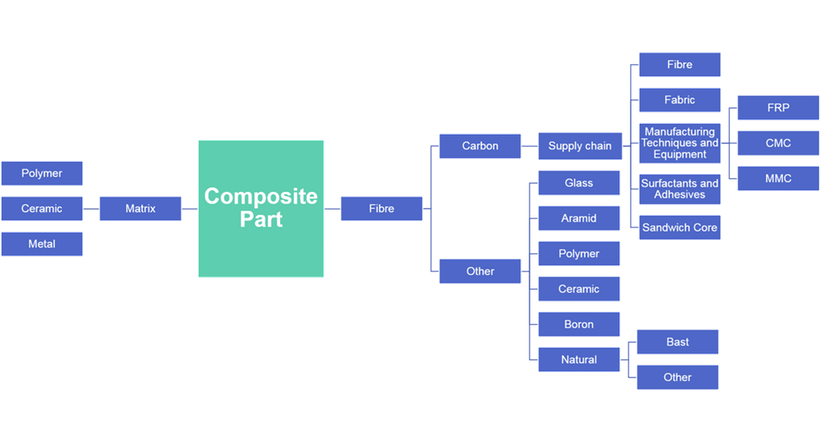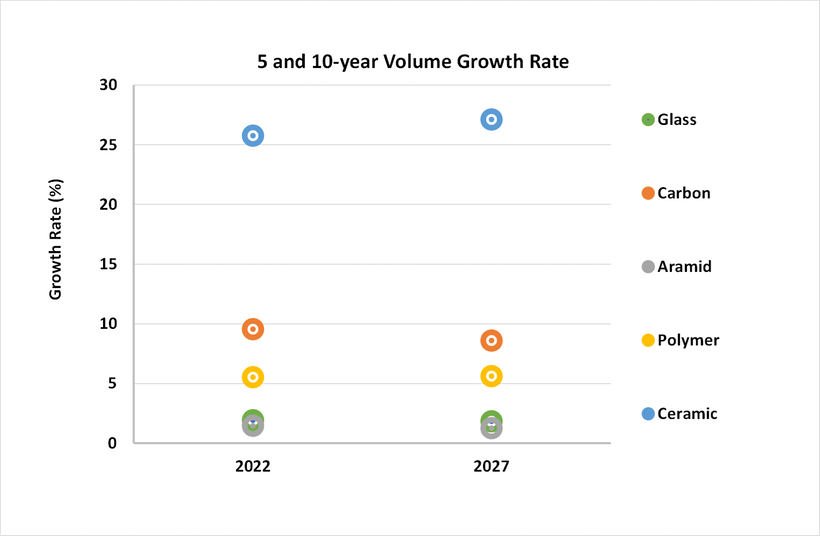A composite part consists of fibres embedded in a matrix to give superior properties in comparison to their individual elements. This report provides the most comprehensive global view of this market with detailed sections,10-year forecasts, and application trends segmented for each synthetic and natural fibre in a polymer, metal, or ceramic matrix.
The industry may appear well-established, but beneath the surface there are many significant innovations at every stage of the supply chain; this extends from the fibres and their precursors through to the manufacturing processes and their associated industries. These innovations are not only providing opportunities for a wide-range of companies at each step of the part production, but are also developing both improved and nascent materials which are taking this market into expanding and emerging applications.
These technical innovations are found in multi-billion dollar companies through to university research. This report contains detailed primary-information and company profiles on over 60 of the most significant companies and research institutes based on IDTechEx’s interview-based research.

Report breakdown for Composites 2017-2027: Innovations, Opportunities, Market Forecasts. The supply chain for carbon fibre is highlighted as an example. (Source: IDTechEx)
The usual headline-grabbing property is the improved strength-to-weight ratio of these lightweight composite parts, and this will continue their ever-increasing relevance for the automotive and aerospace industry, as lower emissions (ICE) and improved mileage (electric) are required. However, important additional properties also play a crucial role in their successful uptake, be it their superior stiffness, corrosion resistance, or temperature stability.
IDTechEx forecast that the market for all synthetic fibres used in composite parts will exceed $9bn by 2027. The report details the current and status of each individual continuous and short/chopped fibre as well as the main players, challenges faced and trends in applications. The fastest growth rate will come from continuous ceramic fibres in the next 10-year period, but the market will also still see significant growth for some of the more established materials. This report also looks further into the future of pre-commercial composite materials, a prime example being boron fibres synthesised by advanced manufacturing procedures.

5 and 10-year volume growth rates for continuous synthetic fibres that are consumed within composite parts. Composites 2017-2027: Innovations, Opportunities, Market Forecasts (Source: IDTechEx)
A detailed analysis into natural fibres, and in particular the emerging role of bast fibres, is also included. Through legislation and a beneficial combination of properties and price, these bast fibres are finding an increasing market, which in some cases cannot be (both literally and economically) grown fast enough to meet the demand.
Owing to the often higher costs and occasional limitations in both physical and chemical properties, it has been increasingly important to use composite materials as hybrid parts. This involves composites being used in combination with dissimilar materials in a variety of ways. This report probes the methodologies facilitating this trend and highlights the applications where these have been and will be used.
There are additional downsides to composite materials which many advocates of the field shy away from, and this is the ability to repair parts and their end-of-life opportunities. IDTechEx do not view these as insurmountable negatives, but instead assess the range of emerging and innovative necessary solutions to these hurdles.
Finally, this report looks at the role of composite parts beyond purely „dumb” materials into what will be their next frontier. Multifunctional composites are where the structural part can also provide additional functionality which typically acts as a weight and space-saving mechanism. This includes: energy storage, energy harvesting, embedded sensors and structural health monitoring, adaptive responses, and thermal/electrical conductivity.
Read more at: http://www.idtechex.com/research/reports/composites-2017-2027-innovations-opportunities-market-forecasts-000544.asp